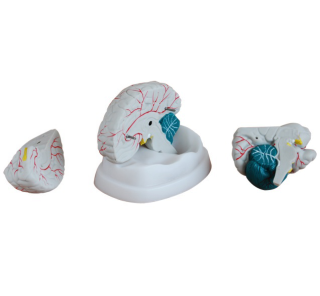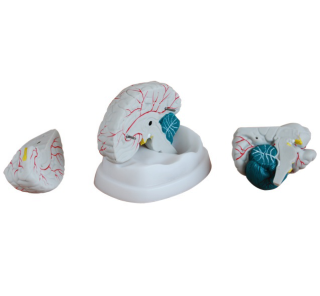One of the core challenges of medical education is how to effectively translate theoretical knowledge into clinical practice skills. In traditional medical education, students first master the theoretical knowledge of anatomy through classroom study, and then apply the theory to practical treatment through clinical practice. However, this process often lacks sufficient hands-on opportunities, resulting in students who may not feel confident or skilled enough when dealing with real patients. Brain anatomy model, as a teaching tool, provides an important breakthrough to solve this problem. It not only provides students with an intuitive, actionable learning platform, but also helps students accelerate the transition from theory to practice.
Brain anatomical models and personal growth

For medical students, understanding the structure and function of the brain is an essential part of their academic career. Traditional anatomy teaching usually relies on atlas or cadaver specimens, although these methods have certain learning value, but often lack enough interaction and three-dimensional sense, it is difficult to help students establish a comprehensive spatial cognition. Through the design of its three-dimensional structure, the brain anatomy model enables students to gradually establish a clear understanding of each part of the brain through repeated observation and operation. This tactile, decomposable way of learning greatly enhances students' ability to grasp brain anatomy, and also makes them more confident and competent when facing practical clinical problems.
Data support: A study of medical students showed that students who used a brain anatomy model to learn the brain anatomy improved their understanding and spatial memory accuracy by 35 percent over traditional teaching methods. In addition, the students who participated in the simulation training performed significantly better in the clinical practice than the students who did not use the model, especially in the neurological examination and diagnostic skills, with higher operational accuracy.
Teaching model application of brain anatomy model
Brain anatomy model can not only improve students' cognition of brain anatomy, but also effectively promote the combination of theory and practice. By introducing brain anatomy model into teaching, teachers can design a series of interactive teaching activities to help students consolidate anatomical knowledge and improve practical ability in real learning situations. For example, teachers can guide students through the model to learn how to identify the location and function of different brain regions, and simulate relevant neurological diseases, so that they can make diagnosis and treatment decisions more quickly in the real clinical environment.
The brain anatomy model can help students to practice many times in a simulated environment and quickly master the essentials of basic anatomy. This way of "clinical rehearsal" in advance shortens the adaptation period of students in the clinical stage, so that they can deal with complex brain diseases more quickly and effectively.
Data support
According to the results of a survey of medical schools, courses taught using brain anatomical models improved the diagnostic accuracy of students at the clinical stage by more than 30%. Specific to the diagnosis of brain diseases, such as brain tumors, cerebrovascular diseases and other fields, students using the model are able to more accurately identify the location of the disease and related symptoms. In addition, by using the model for multiple simulation training, the students' reaction speed and diagnostic decision-making in the actual operation are also significantly improved.
conclusion
As a teaching tool, brain anatomy model can effectively accelerate the combination of theory and practice in medical education. It not only helps students better understand the structure and function of the brain, but also improves students' clinical thinking and operation ability through repeated simulation training. With the continuous development of medical education, brain anatomy model will become an indispensable part of medical curriculum and provide strong support for training higher level medical talents.

